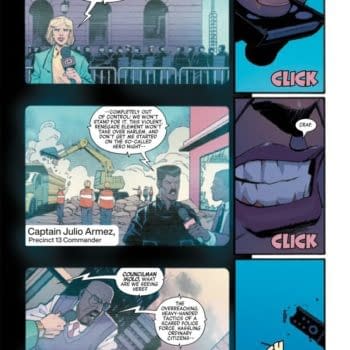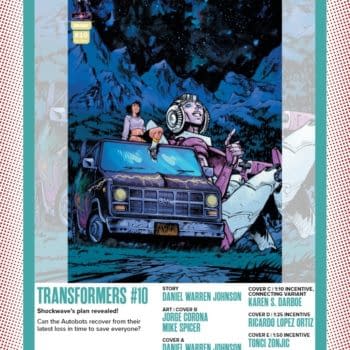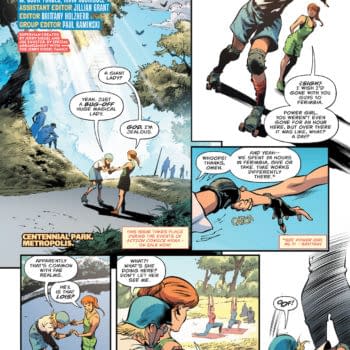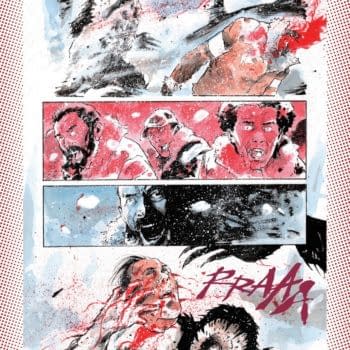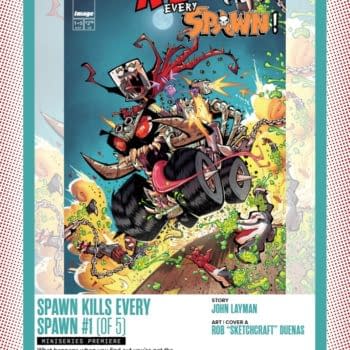Posted in: Comics, Recent Updates | Tagged: Blastosaurus, boom studios, Brandi Bare, Charge, Comics, ComiXology Submit, Edward Scissorhands, entertainment, goners, Greye of Scotland Yard, idw, image, Jim Henson's The Storyteller: Witches, memetic, only living boy, Parallel Man: Invasion America, The Only Living Boy
Thor's Comic Review Column – Blastosaurus, Brandi Bare, Greye Of Scotland Yard, The Only Living Boy, Parallel Man, Charge, Memetic, The Storyteller: Witches, Edward Scissorhands, Goners
This Week's Reviews:
Blastosaurus #10
Brandi Bare #4
Greye of Scotland Yard
The Only Living Boy #3
Parallel Man: Invasion America #2
Charge #1
Memetic #1
Jim Henson's The Storyteller: Witches #2
Edward Scissor Hands #1
Goners #1
Small Pressed: A Sextet from Submit
By Graig Kent
Back in my youth, I had an aspiration to read all the comics ever made. Maybe not a true objective, but a dream which I tried to fulfill by stacking my life with comics and taking any opportunity to read a new title or issue that may come my way at little or no cost. I realized long ago the futility of such a drive. Yet, even until recently I still aspired to ingest as much of the medium as possible, even just limiting myself to those books for which I read favourable reviews or interesting solicitations still proved overwhelming. I just don't have the time, energy or dedication I once did.
Being in the review game, I get a decent amount of review material sent my way, and most weeks I don't even have the time to touch it for all the higher profile product I still pay for that almost demands to be discussed. It's a little unfair, and definitely unfortunate that the smaller guy doesn't get the same consideration as the bigger guy. I will even admit to having a lot of prejudice about smaller press books, a not altogether unearned reputation for lacking in quality or professionalism, at least comparatively speaking. But that's not to say there's not some good stuff that's being produced outside Diamond Distributors' favored players, it's just that most of the time it's difficult to find, and even more difficult to discover in the first place.
Comixology Submit offers a home to the self-published and independent small press, and while its catalog is far more accessible than an off-line model, it's still got a myriad of titles to wade through, with dozens of new ones coming in on the regular, one doesn't know exactly where to start. I chose to dive into a selection of this weeks new issues, and see not just what I've been missing, but what I could discover.
Blastosaurus #10 (Square Planet, $1.99): I'm fascinated by the fact that there are series on Comixology Submit that have lasted 10 issues or more. Blastosaurus lives life as a web-first series written and illustrated by Richard Fairgray (with co-writer Terry Jones… but not that Terry Jones…I think). The basic premise finds a mutated time-displaced dinosaur working as a detective for the Freak Out City police. You know, that old chestnut. This issue seems to side-step the central thrust of the series (action dino-cop) and focuses on a marginal member of the supporting cast, Marvin Morris. He's one of those stereotypical guys who turn to some form of security or law enforcement as a power trip to escape the emasculation they faced either at home growing up or at school, or both.
Without explicitly saying so, Fairgray paints Marvin's as an insecure average guy who obviously expected life to be different once he became a cop. But he still can't get the girl, he still doesn't get respect and acclaim (not that he's earned it either), and he's still not popular, especially not with a mutant triceratops walking around, nor his little brother. Blasto's sudden rise to prominence both in the public eye and in the precinct cause Marvin much consternation, but even more, the dinosaur is partnered with the object of Marvin's affection and she just has no time for him. Fairgray walks the line between pathos and pathetic with Marvin, and does so masterfully, and for a new reader like myself, it really does give an outside-looking-in view of the Blastosaurus world, which I'm sure is much, much weirder than this charming, almost mundane aside displays. Fairgray's art is fantastic, rich with naturalistic detail and affirmed lines. He has a Marshall Rogers vibe that grounds any weirdness well in reality. Definitely worth checking out and investigating past issues.
Brandi Bare #4 ($2.99): Here's a comic I don't know what to do with. If this issue is anything to go by, it's a semi-fantastical, feminist, cheesecake, post-teen, romcom romp about five college roommates, with some geeky underpinnings. This issue is about the girls — Brandi, Xian, Rosie Dylan, and Alice — making their way to a comic convention in the wake of Brandi breaking her leg, but it starts off with Brandi having a Disney-esque fever dream, featuring a wicked witch, a strung-up barbarian romantic interest, and a trapped bear. In real life, she awakens in a hospital bed, her friends trying to convince her father to let her go to the comic con they're already all bustily cosplayed out for. A laughably absurd flirtation with the attractive doctor has Mr. Bare agreeing, and the girls are comic con bound. The con is pictured as both a celebration of geek, and its seedy underbelly, which creators Joe Pekar and Jeff Outlaw nail somewhat, but in far too exaggerated tones. On the one hand they seem to understand the plight of female comic fans, not just as con attendees but as readers as well, but at the same time it doesn't stop them from creating ogling butt-shots and glossy cleavage and (in a backup story) a shower-together sequence.
I'm not against titillation and cheesecake but gussying it up under the guise of girl-power (again the side story features a particularly triumphant rant from Dylan which is completely undercut by girls having their towels knocked off) seems to betray the message. The two stories in this plus-sized issue are Disney XD-worthy (teen-styled romance, comedy and drama), but the cheesecake imagery is more Cinemax ready…an Archie Comics for horny teenage boys. It's made all the more unfortunate since Pekar's art is astounding, truly refined stuff. His coloring creates the effect of cel animation and it's a truly beautiful book to look at, but his execution of the story (moreover, the characters) shows an immaturity in content that could easily be suppressed. But I have to guess that with a stripper-tastic title like "Brandi Bare" Pekar and Outlaw know exactly what kind of story and art they want to put out there. There's a real hint of something worthwhile here, but I get a feeling it's never going to fully evolve.
Greye of Scotland Yard (Play/Books,$1.99): This book of stories could've began life as a web series, or serialized in a newspaper. Each page of Graye is consistently two stacked rows of 5 panels each with a copyright mark at the end of each row that might as well say "King Features Syndicate". Greye's creator, Stephen Sonneveld has developed this work within the comic strip-like five panel format and the story plays out cannily row-by-row. I cannot seem to find evidence that Greye began life online or in print elsewhere, but, wow, does Sonneveld ever nail the structure, and I'm sure it would've been a cracking read on a serialized basis. I've been reading a lot of the Titan collections of James Bond and Modesty Blaise newspaper strips, and while Sonneveld's Paul Grist-like art (if even more simplistic and asymmetrical) doesn't quite stack up to the likes of Enrique Badía Romero or Jim Holdaway, his story craft is on par with those runs, although working in the police mystery genre rather than espionage.
This book, running 298 strips (a steal at $1.99), follows Detective Chief Inspector Greye across five cases as his avant garde policing style has him booted from one division to another, at one point jobless and even arrested. In a book where the lead character's face is covered in bandages (after being horrifically burned), Greye is one of the most normal looking of characters, as Sonneveld's England is populated by all manner of weird beings, including an egg-shaped CI, a coneheaded MI5 liaison, a batboy victim, and a button-eyed news reporter. I wonder if there's metaphor at play I'm just not getting or if it's abstract for abstract sake. Greye plays out like five episodes of a really good British police drama, Luther especially comes to mind in the segment where Greye catches on that a killer's pattern is a game. There's a rather dour finality to the book which sullies its end rather unnecessarily, but it's otherwise a tremendously fulfilling read. Recommended.
The Only Living Boy #3 (Bottled Lightning, $1.99): What I generally expect from smaller press is young writers and artists with few resources to make a really polished book, and 3 out of 4 times that's what I receive. I can value those books on their own merits but most of them have a more difficult time stacking directly up against the works from bigger companies or more experienced professionals. But then there are books like The Only Living Boy from writer David Gallaher and Steve Ellis, an indie book guided by the assured hands of professionals who may have toiled in somewhat obscurity but still have an impressive amount of experience behind them. Here they've put that experience into an all-ages fantasy-adventure comic that is brazenly confident and likeable, with an astounding level of creativity and eye popping designs.
I was half expecting a straight-up Kamandi rip from this book (especially when reading the name of this fantasy world: Chimerika), but Gallaher and Ellis forge their own reality about a boy who wakes up in a new realm, perhaps our future, where no more humans exist and all manner of strange beasts, both sentient and primal, roam the unrecognizable land (though schattered with hauntingly familiar features). Page after page Ellis manages to surprise with newer and stranger settings and creatures, made all the more wondrous by the top notch coloring (by Ellis with color flatting by Mike Paar and Ten Van Winkle). The story scope may prove a little basic for some tastes, but it captures a real Wizard Of Oz or Neverending Story feel without any allusions made. It's a fresh adventure, wild and vibrant, I look forward to collected editions for my kids' bookshelves.
Parallel Man: Invasion America #2 (FutureDude Entertainment, $3.99): While this is a book about alternate dimensions, it feels like a book lost in time. Like the last gasp of sci-fi action-adventure movies in the early 1990's (think Total Recall or Time Cop), or the waning days of the X-Files and its derivatives (Sliders, Dark Skies) at the end of the millennium, there's high concept storytelling, exceptional melodrama, and a wealth of delicious pseudo-science and clunky "future tech". It's so "of that era" that it should feel familiar, redundant even, but it doesn't. And while it may feel dated, it doesn't feel outdated. It feels warm and inviting, fun and exciting. There's no pretense here, this isn't high-fallutin' sci-fi, nor is it campy SyFy, it's just solid entertainment. In a parallel dimension to "our own", a technologically advanced American government, called The Ascendancy, has developed a weapon that can subjugate an entire planet in the click of a button. Agent Nick Morgan discovers his long lost grandfather on an alternate Earth — "our" Earth — and rejects the Ascendancy while also absconding with the trigger to a rebel weapon that can stop the Ascendancy.
The best moments of the book are how the "real world" reacts to the presence of all this alternate tech, or "our" Nick Morgan suddenly arriving on a parallel plane of existence. Writers Jeffrey Morris and Fredrick Haugen craft a delightfully dense tale that magically avoids convolution, sewing multiple story threads with relative ease. Artist Christopher Jones is a mainstream industry vet of over 20 years who, somehow, I've never heard of. His style is richly detailed, but clean and without clutter and line noise. He falls somewhere between Jerry Ordway and George Perez on that scale, and he captures the tone of this book perfectly (and again, is accompanied by terrific coloring from Zac Atkinson). This one I must go back and read the first issue of. It may not be to everyone's tastes, but those that get its sensibility will love it.
And finally, there's Charge #1: An All Super-Heroes Must Die Comic (JTRO Comics, $3.99): There was something familiar about this title that I had to do a little research before I read this book. Why would it feature a subtitle like "An All Super-Heroes Must Die Comic"? What did that mean? And with a simple Google click, I suddenly remembered watching a trailer a while back for an independently produced feature film called All Super-Heroes Must Die. I watched the trailer again (hey, James Remar!) and read the comic, and it would seem to me the comic is an adaptation, or perhaps expansion of the film. While I can't comment on the movie (I've seen all of one minute and thirty-two seconds of it), the comic book shows what the trailer hints at, a rather commonplace superhero story with heavy Watchmen and Dark Knight Returns influences. It opens with one guy in a costume being thrown off a building by another guy in a costume, and the formation of a new superhero group in the wake of a string of vigilante deaths (as well as the sudden appearance of superpowers in this world). It's a script filled with a lot of convenience for convenience sake, and the characters seem aptly ill-equipped to handle the "hero" roles they have adopted.
This is going to be one of those stories where the novice adventurers bite off more than they can chew, and probably don't have the chance to learn and grow from it. It's not altogether a bad book, or really in most ways a bad book. It's just familiar. The art is really, really nice Steve Dillon-type work from Gavin Smith, with a J.G. Jones-like adeptness at shading. Smith definitely has a promising future in the mainstream (I bet he's drawing The Punisher before the decade is out). He's really worth the price of admission alone. Fans of the genre who don't mind seeing a lot of common story tropes dished out once again in a somewhat different way will still find some really likeable elements, particularly the last panel where the supervillain says "These are the ones who stole my powers." That's an exciting twist. I'm not altogether disinterested, nor am I unimpressed, but it will take a second issue to see if this is a story that can move beyond its inspirations.
And there you have it, six independently produced books that may not be published in the mainstream but can certainly compete without any concessions. In fact, some of them present stories or art, or both, which match or exceed (or simply creatively diverge from) the material of the major players. I'm impressed with (and a little bothered by) the quality of material that can fly under the radar, and must remind myself to take the time and energy to branch out more often, because I like the reward when you find something good, or new, or interesting.
Graig Kent has a lot of comics, but very few of them are digital. His collection, currently housed in his shed, is causing that structure to sink into the ground with its massive weight. He should perhaps have more digital. He is occasionally on twitter @thee_geekent, and his corgi has a photoblog tacomblur.tumblr.com.
Memetic #1 (Boom! Studios)
By Bart Bishop
I know this is something I harp on too often, but it's so refreshing to encounter organic diversity in popular fiction. Comic books, in particular, are a medium mostly free of the pressures of public expectations, and indie comics have always had carte blanche when it comes to experimenting with character. With Memetic, the new mini-series from Boom! Studios by James Tynion IV and Eryk Donovan, they manage to not only feature main characters that are a gay man, a black man and an Asian woman, but simultaneously tell a mature, complex and topical storyline that most of all rings true in what it's trying to accomplish. The first of three issues, Memetic #1 taps into the zeitgeist of 21st century tech-obsessed culture, with a vast swath of the world's population afflicted by a picture that manifests out of social media and spreads like wildfire. In the spirit of such prescience as Videodrome, Snow Crash and Cell, Memetic is horrifying in its believability.
Aaron is a student at Jefferson State College that is color blind (and also has a hearing aid, although it's unclear whether that's important to the plot), so when a picture known as the "Good Times Sloth" goes viral online propelling 500+ million people into heights of euphoria, he is one of the few left unaffected. Within twelve hours those that have seen the sloth have gone insane, transformed into screaming engines of violence. Meanwhile, Marcus is a former head of intelligence stricken with blindness that immediately suspects foul play, remembering how his one-time assistant Barbara had published a paper on the potential for weaponized memes. When the world goes to hell, Marcus and Barbara are already prepared, but it may be too late to stop the onslaught. With a flash forward to three days later it's clear that the United States' infrastructure and populace have been mercilessly thrust into a post-apocalypse landscape, although it's still a mystery who perpetrated this attack.
My only experience with James Tynion IV so far has been with his Batman work, so it's a pleasant surprise that he can downshift into a completely different kind of story. His handle on the scope and scale of the disaster, as well as the functionality of how it works, is terrifying in how it could be ripped from the headlines. Concurrently, his understanding of human behavior and how people interact with technology rings so true as to be uncomfortable in its implications even before people start tearing each other's faces off. This is all dramatized economically and efficiently with lead Aaron, who functions as the audience surrogate reacting to the strangeness of the people around him but is simultaneously introduced reaching out to his boyfriend via text and then, out of frustration, tweeting about it. Aaron is indoctrinated as much as anyone else and survives, at least at first, out of sheer luck. Tynion, meanwhile, effortlessly code switches between Aaron and Marcus, an older black man with a military background, and news anchors and even President Obama. This is all permeated with the aforementioned diversity, with Aaron's disabilities and homosexuality presented as personality shaping rather than perfunctory and characters' skin colors as a reflection of the broad spectrum of modern society.
Eryk Donovan's artwork is, what I feel, most suitable for the comic book medium. It has a cartoonish overlay but clear sense of style and distinctive featuring. Each character stands alone, from Aaron's nose ring and haircut to Marcus's cane and graying hair. Once the chaos erupts Donovan handles the boiling over with aplomb, with a special emphasis on the eyes and the unnatural, deeply disturbing shots of blood seeping from orifices. What's most impressive is the incorporation of an Internet aesthetic into the everyday lives of the characters, with instant messages, status feeds and texts floating through the air with particular color schemes, designs and font as signifiers. It really highlights how much the wired world dominates everyone's lives. Again, Aaron is so relatable because he is not exclusive but advantageous, as the final pages provide a bit of background and behind-the-scenes commentary in the form of a Facebook page. Very cool.
All in all, a very exciting read that hits a bit too close to home.
Jim Henson's The Storyteller: Witches #2 (Archaia, $3.99)
By Cat Taylor
Boom! and its various imprints seem to be having a field day lately with comics attributed in some way to Jim Henson. The Storyteller mini-series is based on a Jim Henson television series that ran several years ago. Unfortunately, I never saw that show but the premise of taking old folk legends and fairy tales and adapting them into one-shot television stories is something I'm certain I would have enjoyed in the same way I enjoy shows like Twilight Zone and Outer Limits.
This adaptation of sorts includes four issues of standalone folk stories about witches, although the term is applied pretty liberally, at least in this particular case. The "Snow Witch" or "Snow Woman" in this story doesn't seem to be so much a witch in the traditional sense of a mortal who uses magic, but rather a god-like immortal, or more accurately, a magical force of nature. At any rate, the story is adapted from an old Asian folk tale. Although I don't believe I have heard the original story before, upon reading it I realized that a number of horror shorts I have seen or read seem to be based on this tale. As a result, I felt like I knew how it would end. It turned out that I was partially correct. However, in the American horror versions of this story the ending is always much more tragic. While I wouldn't call the ending of the Snow Witch "happy," it is not the outright, hopeless tragedy that I expected. Perhaps a lot of that is in the differing natures of Eastern vs. Western fables and morals.
Kyla Vanderklugt, the writer and artist of this issue, has some experience with similar material from previously writing and drawing the Labyrinth issue for this year's Free Comic Book Day. As luck would have it, even though I got a LOT of books on FCBD, wouldn't you know that I missed that one? If you were lucky enough to get a copy then you may have an idea as to how much you will enjoy this issue. Regardless, Vanderklugt consciously uses an art style in this issue that captures the Manga look that is all the rage, but she does so with a flair that is in keeping with the more ancient Asian art that you would more likely see on an old print rather than in a Speed Racer cartoon. Furthermore, the issue and its art are printed in a horizontal format, similar to most of the collected editions of comic strips that I've seen, rather than the standard vertical layout of most comic books. Even though the story is still told in the standard Western left to right progression, somehow the horizontal design makes it feel more like an Asian comic to me.
While comics like this aren't what most comic book fans buy most frequently, it's undeniably a good story with quality artwork. It's also an easy format to digest being that it is self-contained and short.
When it comes down to it, folk tales and fables are the foundation for all fictional adventure stories. So, any fans of storytelling should be able to appreciate this and the other Storyteller issues. How highly one values it probably depends on one's love for old fables. However, be warned that these tales are more-or-less straight adaptations of the original stories. If you think you love those old tales based on modern comics such as Fables and Grimm's Fairy Tales, or television shows like Grimm and Once Upon A Time, the Storyteller series is quite different, going back to the original stories rather than turning public domain characters into edgy action heroes.
Cat Taylor has been reading comics since the 1970s. Some of his favorite writers are Alan Moore, Neil Gaiman, Peter Bagge, and Kurt Busiek. Prior to writing about comics, Taylor performed in punk rock bands and on the outlaw professional wrestling circuit. During that time he also wrote for music and pro wrestling fanzines. In addition to writing about comics, Taylor tries to be funny by writing fast food fish sandwich reviews for Brophisticate.com. He wonders what comic book adaptations of Andy Rooney's old complaining segments from the CBS Evening News would be like. There's a lot of curmudgeoness to work with there. You can e-mail him at cizattaylor@hotmail.com.
Edward Scissorhands #1 ($3.99, IDW)
By D.S. Randlett (@dsrandlett)
I was just a year or two too young to really get what the nineties were all about, or what they were about for the generation just beyond my grasp. Sure, I was into Ninja Turtles, Batman: The Animated Series, and Animaniacs, but there was stuff for a crowd just a bit older than me at the time. I was too young for Sandman upon its initial release, and even though I would read it later in its collected form, there was this niggling feeling that I had missed out on a particular moment, and as such this work that I loved would never really be mine the way it was to readers who had the good fortune to be just a few years older than me. The same could be said for my relationship to Tim Burton. Although I loved Beetlejuice, and would come to love Edward Scissorhands and Ed Wood, I had been too young to really catch on to that particular cultural moment, and so those films would mean something very different to me than to people who were in that window.
When I saw that there was a new comic book out continuing the saga of Edward Scissorhands, I was kind of flummoxed. Why would IDW, the premier publisher of these continuing stories of certain films and TV Shows it seems, decide to continue this story, especially such a decidedly personal one that ended on a lovely note of lyric melancholy? I had to check it out if only to see what the deal was.
A quick look at the back matter reveals what will be the thematic focus of the series: angsty, awkward teenage years. This was interesting to me because I was a teenager in a very different context in a very different sort of place than Edward Scissorhands really depicted. The film didn't speak to me so much about that specific time in my life, as much as it was about the internal troubles of being an outsidery artist type in the figure of Edward, along with the realization that the world was, in reality, a much bigger place than mainstream American culture (which the film never really sneered at) was willing to admit or accept, in the figure of Kim.
One issue in, something here feels lost. It's not as if this comic book is particularly bad, as Kate Leth's script is often pretty dang good, but the thematic meat of Edward and his world has been stripped to the bone. As a result, the book's concerns and its treatment of its unusual characters ends up feeling rather typical. Part of this is just down to length, as the first chapter in a serialized comic book story rarely ever fully airs out its themes. Hell, it took the film itself a while before its nuances really came out. This story, involving Kim's granddaughter and a sinister mechanical foundling, is still in its first act. Still, this comic is very many things. It is often funny, it is often stylish, but as yet it lacks the dramatic heart of its source material, and I really hope that it finds it.
Another thing. Drew Rausch's art, while stylish, emotive, and really capturing the cartooning style of Burton, fails to really play up the contrast between Edward's world and the suburban world. The colors do a lot of the heavy lifting as far as this is concerned, as they did in the film, but the framing compositions in both contexts feel similarly off kilter and of the same piece. If Rausch brought more of a sense of seething restraint to his compositions in the scenes set in Suburbia, that visual contrast would pay dividends in terms of the way this book feels.
Not the strongest start, but while Edward Scissorhands doesn't quite capture the spirit of its source, it finds ways push a lot of its key concepts into some interesting new places. Leth and Rausch are obviously very talented and capable, and it would be great to see this book grow into something special, and that might take a few issues. But then, maybe it's my priorities that aren't aligned properly. After all, Edward's world was never mine in the way that it seems to have been for the people behind this book.
D.S. Randlett lives in the hills of Virginia and takes credit for the reviews that his emaciated twin brother writes while chained to the old radiator. He plays his guitar while biding his time for unsuspecting tourists and thinking about going to grad school.
Goners #1 (Image, $2.99)
By Jeb D.
The burden of family legacy upon a group of monster hunters was the centerpiece of one of the best comics of the 70's, Marv Wolfman and Gene Colan's Tomb of Dracula. While Blade was more or less the breakout star, the overall story was driven by the relationships among the characters with their lineages of Harker, Van Helsing, and Dracula himself. Horror comics have come and gone in the years since then, but I'm not sure I've seen one so similarly focused on the responsibilities that come with the familial heritage of opposing evil as the first issue of Jacob Semahn and Jorge Corona's Goners.
While the cast of Tomb of Dracula was a veteran unit fighting the Count and his plans, alternating small victories with tragic failure, Goners picks up at the twilight of the legendary Latimer family's centuries of opposing the forces of darkness. The brief, bloody introduction of an aging, unnamed Latimer is heavy with portent (are we seeing the past? or the future?), and we're then thrown headlong into what turns out to be the final adventure of the husband and wife team of Raleigh and Evelyn Latimer—not exactly a spoiler, since that's made clear in the premise. This will be the story of how a pair of barely-prepared adolescents—Raleigh and Evelyn's children, 17-year-old Zoe and 12-year-old Josiah—will carry on as the final members of the monster-fighting family.
The script is a bit choppy; there's a lot of world-building in any comic of this type, and the exposition gets particularly tricky when it's basically all backstory, the history having taken place before the principal characters actually come on stage. The setup is intriguing enough to launch a series, but what will make the difference will be whether Semahn can flesh out Zoe and Josiah, along with the stolid Francis, their parents' right-hand man who is now going to have to tangle with the responsibilities of both fighting evil and supervising adolescence. To this point, they're actually pretty run of the mill for the types; the most interesting element of this first issue is Lyle McCarthy, a police detective with an engagingly matter-of-fact perspective on the fantastic doings in his community.
Corona's art is on the manga-cartoony side, angular, precise and energetic. With colors from Gabriel Cassata—vivid ben-day dots in the contemporary setting, sepia-wash in the flashbacks—the art team definitely comes down heavier on the adventure than the horror, stressing action over mood, more Jonny Quest than Buffy.
Teenage monster hunters have been pretty thick on the ground since the days of Scooby-Doo, and sticking with the story is always a question of the specific hook. At this point, I'm actually less intrigued with the characters of Zoe and Josiah than I am with the slightly off-kilter world that they seem to inhabit, and given how overmatched the kids seem to be against their spectral foes, I'm waiting to see if Semahn's presumed plans to even the odds for them will open up more of it.
Jeb D. is a boring old married guy whose comics background includes attending the very first San Diego Comic-Con, being lectured on Doc Savage by Jim Steranko, and fetching an ashtray for Jack Kirby. After a quarter-century in the music biz, he pursues more sedate activities these days, and will certainly have a blog or Facebook account or some such thing one day.




















